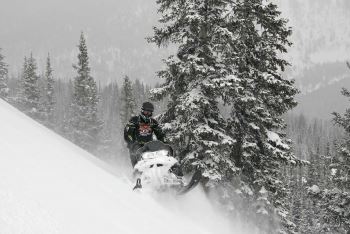 Take an already proven deep snow chassis, the industry's largest displacement engine, remove a bunch of weight and put arguably the best mountain track to date under it.
Take an already proven deep snow chassis, the industry's largest displacement engine, remove a bunch of weight and put arguably the best mountain track to date under it.
You've just built the 2009 Arctic Cat M1000.
Entering its third year, the M1000 continues to improve its monster class notoriety and continues to lead the way to the top of the hill. The Ski-Doo Summit has long since disappeared from the 1000 class, but that doesn't mean Cat has been sitting back on its haunches over the past year. There is always room for improvement and the M1000 attacks the western mountains with more authority than ever before.
The M chassis has already proven it can perform in the deep stuff. The lay down engine design, front suspension and overall chassis design make it one of the nimblest and most maneuverable powder sleds on the market. Cat's engineers have gone one step further and made an `09 M sled we think will please current Cat owners and convert the non-believers.
From A Higher Power
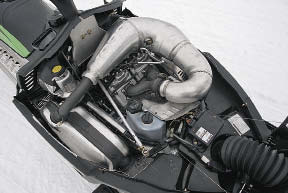 Let's start with the power plant, which remains basically unchanged from the 2008 model. The 999cc two-stroke still sits on top of the horsepower charts with a potent 162 ponies. Two spark plugs per cylinder are still used to control fuel atomization, decrease emissions and improve fuel economy.
Let's start with the power plant, which remains basically unchanged from the 2008 model. The 999cc two-stroke still sits on top of the horsepower charts with a potent 162 ponies. Two spark plugs per cylinder are still used to control fuel atomization, decrease emissions and improve fuel economy.
One of the SnowTesters at our sneak peak ride this spring wrote, "Illusive power, you definitely know it's there, but not overwhelming, just pulls and pulls." If you're a horsepower junky, this is the sled for you. Power never seems to be an issue on this sled, it's there when you need it and very manageable when you don't.
Cat continues to make improvements with the fuel mapping on all its fuel-injected sleds and that includes the M1000. Fine-tuning and tweaks in programming continue to improve an already great running machine. The M1000 models we were able to spend time on ran flawlessly, power comes in smooth and continues to pull all the way to redline. There's something to be said about a big bore sled that can accelerate this smoothly. Cat engineers have done a great job with this engine platform, limiting that "on/off" two-stroke powerband feel.
Calling Jenny Craig
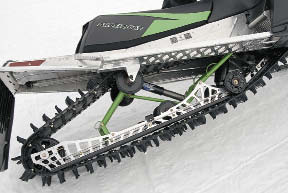 Here in the West lightweight is the name of the game. Arctic Cat engineers knew the M sleds would need to go on a dieting regimen to keep up in the western snowmobile market and the M1000 was not to be left out. Engineers went over each and every aspect of the machine, looking for every last pound possible.
Here in the West lightweight is the name of the game. Arctic Cat engineers knew the M sleds would need to go on a dieting regimen to keep up in the western snowmobile market and the M1000 was not to be left out. Engineers went over each and every aspect of the machine, looking for every last pound possible.
Let's start with the rear suspension changes. While the Float skid frame still resides under the tunnel, Cat dropped another 3.5 lbs. by changing cross shafts to tabs, machining the rails down, using smaller 5/16-inch bolts, narrowing the limiter straps and then switching the rear axle layout to an inside 2-wheel kit.
Up front the A-arm suspension remains the same from the 2008 model year with only minor changes to some of the building materials. Steel bushings were traded out for anodized aluminum ones, the ski carbides were shortened an inch and steel ski spacers were replaced with plastic ones. All those changes net another 1.7 lbs. off the already nimble M Series. While 1.7 lbs. may not seem like much, it's weight loss that you'll feel when laying over into the sidehill. This weight loss at the outermost edges of the sled help with balance and decrease the amount of leverage needed to lay the machine over in the deep stuff. It's an improvement we were very happy to see on the somewhat nose-heavy M1000.
 The tunnel design has also gone through some pretty major changes, not only shedding some weight but also greatly improving the M1000's ability to cut through the deep stuff. Running boards no longer run clear back to the bumper. Now ending just behind the seat, they no longer cause dragging issues when trying to attack a steep hillside, allowing the track to reach for every bit of traction available. The outer edge of the running boards has an aggressive bite that angles upward into the tunnel at the rear, making for great foot placement and traction, no matter the condition.
The tunnel design has also gone through some pretty major changes, not only shedding some weight but also greatly improving the M1000's ability to cut through the deep stuff. Running boards no longer run clear back to the bumper. Now ending just behind the seat, they no longer cause dragging issues when trying to attack a steep hillside, allowing the track to reach for every bit of traction available. The outer edge of the running boards has an aggressive bite that angles upward into the tunnel at the rear, making for great foot placement and traction, no matter the condition.
The shortened running boards also allowed Cat engineers to get more aggressive with tunnel taper and bumper design, improving snow evacuation and eliminating the chances of getting hung up in the powder on those tight technical maneuvers. The aluminum bumper not only sheds some weight but also adds some strength to the rear of the machine. A new LED brake light wraps up the rear. Arctic Cat opted to lose the standard gas rack and integrate innovative tunnel access points, offering numerous mounting locations for a number of different Arctic Cat accessories. The new tunnel design also allows the use of a shorter cooler, helping shed some unneeded weight while still maintaining plenty of engine cooling. Overall the improvements in tunnel design have helped improve this big bore's already impressive hillclimbing abilities. Not many sleds out there will rival this machine on a long, steep climb to the top of the hill.
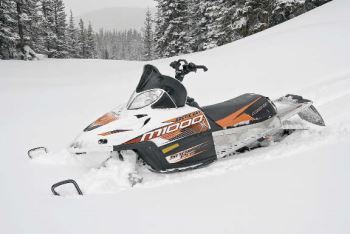 The most significant weight loss came from Arctic Cat's introduction of an electronic reverse system. Gone is the heavy, gear-driven Diamond Drive reverse mechanism. Arctic Cat Electronic Reverse (ACER) works similar to Ski-Doo's technology: it will stop the engine and reverse its rotation, sending your forward running clutches and drive train into a backward motion. The clutch helix needed to be redesigned to allow it to run in reverse and a voltage regulator has been added to the machine, but overall Cat dropped nearly 7.5 lbs. from the `09 M1000 with this inception.
The most significant weight loss came from Arctic Cat's introduction of an electronic reverse system. Gone is the heavy, gear-driven Diamond Drive reverse mechanism. Arctic Cat Electronic Reverse (ACER) works similar to Ski-Doo's technology: it will stop the engine and reverse its rotation, sending your forward running clutches and drive train into a backward motion. The clutch helix needed to be redesigned to allow it to run in reverse and a voltage regulator has been added to the machine, but overall Cat dropped nearly 7.5 lbs. from the `09 M1000 with this inception.
Pure Genius
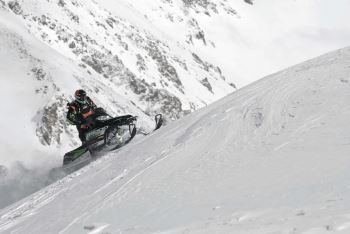 Every now and then some new invention comes along, a new little gadget or a piece of new technology and you find yourself thinking, "It's pure genius." The M1000 Sno Pro and LE models will come standard with Arctic Cat's new telescopic adjustable handlebars. The fully adjustable steering post allows you, the rider, to adjust bar height anywhere from _-inch lower to 3.75 inches higher than the previous `08 model M sleds. It's a feature we've embraced and welcomed with both arms and our lower backs are pretty happy as well. Ten different settings allow you full adjustability while on the mountain. Bring them up taller to cater to your more aggressive riding style for better leverage and more comfortable upright stance, or drop them back down, improving comfort for that cruise back to the truck. Best of all, Cat engineers finished up with only eight-tenths of a pound of added weight, much less than your standard aftermarket two-inch riser block.
Every now and then some new invention comes along, a new little gadget or a piece of new technology and you find yourself thinking, "It's pure genius." The M1000 Sno Pro and LE models will come standard with Arctic Cat's new telescopic adjustable handlebars. The fully adjustable steering post allows you, the rider, to adjust bar height anywhere from _-inch lower to 3.75 inches higher than the previous `08 model M sleds. It's a feature we've embraced and welcomed with both arms and our lower backs are pretty happy as well. Ten different settings allow you full adjustability while on the mountain. Bring them up taller to cater to your more aggressive riding style for better leverage and more comfortable upright stance, or drop them back down, improving comfort for that cruise back to the truck. Best of all, Cat engineers finished up with only eight-tenths of a pound of added weight, much less than your standard aftermarket two-inch riser block.
Fine tuning bar height not only improves comfort but also allows sledders to dial the sled into the best fit for their riding style, making the sled easier to handle and putting the leverage point where it best suits you.
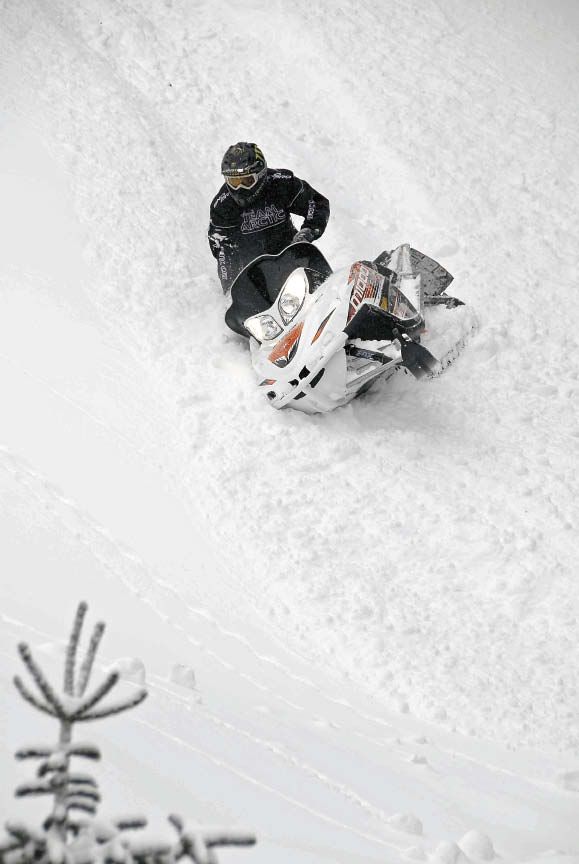 Next thing on the pure genius 2009 innovations list from Cat is the release of the Camoplast Power Claw track. In 2004 Arctic Cat came to the market with what some sledders considered the best powder track the industry had ever seen: the Attack 20. With its half paddle design, soft angled tip lugs and lightweight 3.0-pitch design, there wasn't anywhere the Attack 20 couldn't go. That is, until springtime came and the snow got a little harder. While it worked great in the fluff, it definitely left something to be desired in setup snow conditions, such has groomed trails or late spring riding.
Next thing on the pure genius 2009 innovations list from Cat is the release of the Camoplast Power Claw track. In 2004 Arctic Cat came to the market with what some sledders considered the best powder track the industry had ever seen: the Attack 20. With its half paddle design, soft angled tip lugs and lightweight 3.0-pitch design, there wasn't anywhere the Attack 20 couldn't go. That is, until springtime came and the snow got a little harder. While it worked great in the fluff, it definitely left something to be desired in setup snow conditions, such has groomed trails or late spring riding.
Cat later replaced the Attack 20 with the Camoplast Challenger track, which seemed to be a better all-around mountain track for the M Series, but it didn't throw the Attack 20 concept out the window just yet. SnowTesters think the new Power Claw track on the M1000 is arguably the best OEM track of the season, one. One SnowTester said it may be the best track design the mountain segment has ever seen.
With its half paddle and angled tips, much like the Attack 20 of old, flotation in the deepest, softest powder is not an issue. The track allows the M1000 to stay on top of the snow, rather than trenching through it. What really sets the Power Claw apart from the rest is the addition of stiff fingers along the outer edges of the track. Varying in height and staggered repetition, these fingers offer an amazing bite on the trail and in hard pack snow conditions. The track floats when you want it to, bites when you need it to and carves when you ask it to. The combination of the new Power Claw track and new tunnel design greatly improved this sled's mobility in deep snow, especially while sidehilling. The sled really hooks up well, holding a line across a steep hillside as good, if not better, than any sled on the market.
The `09 M1000 remains king in the horsepower class and with this year's latest improvements, off-trail handling and performance will help keep it out in front of the pack. While not as nimble as some as the 800s on the hill, this smooth powerband and more-than-capable chassis just might be what you horsepower junkies are looking for.